Asus is a name that nearly everyone knows, although very few know for sure how to pronounce it. For years they have made laptops that have been popular with the general population. They have made the hugely popular Nexus 7 tablets, as well as their own Memo tablets but have yet to make any successful forays into the smartphone market. Their offering in 2015, the ZenFone 2, hopes to change that. Read on to find out if I believe it will accomplish this lofty goal.
My first impression of the device was that it is a good looking phone. It may have been the red, which is very striking but the metallic look of the back cover did not give it a cheap feeling that some plastic-backed phones have. The texture of the bottom bezel on the front of the phone gave it a definitely HTC One feeling, although the big Asus logo at the top prevents any confusion. At the time I thought this a a great device but will struggle to compete with the flagships already out there. Little did I know that the version I had was the ZE550ML, a sub-$300 phone. This knocked my socks off when I discovered this.
- Minimal skin, small deviation from stock AOSP
- Good looking device
- Additions see to be decoupled from the ROM and are updated through the Play Store
- Amazing value for money
- Fast charging
- Can slow/lag at times
- Average battery life
- Inclusion of third party software
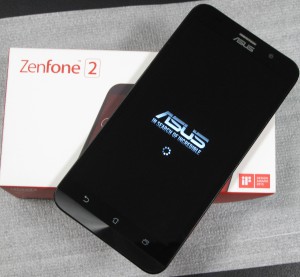
Hardware
The Asus ZenFone 2 is a great looking phone that comes in a few different variations. The variation reviewed was the ZE550ML. The ZE550ML is the version with just 16GB of storage and 2GB of RAM. There is also a version, the ZE551ML that comes with either 32GB or 64GB of storage and 4GB of RAM. There are a few other minors differences between the two versions but I can only speculate about the difference in everyday usage between the two variations. What I can speak about is the ZE550ML ZenFone 2.
The ZenFone 2 has the decent dimensions of 152.5 x 77.2 x 10.9 mm and while big, is not unwieldy. With a 5.5in display it certainly does need to have some size to it. The bezels are not massive and the inclusion of capacitive buttons instead of soft buttons means that the entire 5.5in display is used for exactly that, the display.
The striking difference with the ZenFone 2 and most other phones are that the volume buttons are on the rear of the device and not the side. I liked this position and once I was used to it found it incredibly ergonomic to use. I often have issues with accidental decreasing of the volume of my music while carrying my phone in the gym. No such problems here. On the back is the 13MP camera with dual LED flash, in perfect alignment with the volume buttons. The external speaker holes were at the base of the back cover, keeping with the stylish design of the back cover.
The power button is located at the top of the device which annoyed me immensely having to reach up to turn off the display each time I had finished using it. At least it did until I realised it has double tap to wake (DT2W) which works every single time and did not accidentally turn on the phone in my pocket. The only time I used the power button was to power cycle the device, just as it should be.
The ZenFone 2 is a solidly built device and while it doesn’t have the solid feeling of a one-piece device such as a Samsung Galaxy S6 (or my previous review device, the Huawei Ascend Mate 7) it does feel like a premium phone. The continuous curve of the back cover allows the phone to sit comfortably in the hand, although coming from the surfboard that is the Nexus 6, it’s not a hard call to improve the feeling in the hand. This curved back cover comes off to reveal the two sim slots (yes it is dual sim, and more manufacturers should consider making these) as well as a microSD card slot. I am in agreeance with nearly every single manufacturer out there now, SD cards are an unreliable and messy way to store data in Android. The card speeds are unreliable and the cards are prone to dying. My suggestion for Asus is to make 32 or 64GB standard and forgo the SD slot. Unpopular with some readers I know but surely a person doesn’t need to carry around 30GB+ of music/media every day? That though is an argument for another day. This review phone needs the SD card slot though, having only 16GB of in-built storage so in this case I was glad to have it. The dual sim make this a great phone for those out there who have a work phone and a separate personal phone. The dual sim allows you to use both sims at the same time and yet only carry one device.
While the phone had a removable back the battery inside was not removable, well, not without a small Philips-head screwdriver and painfully removing approximately 13 screws. A strange decision but from what we hear from manufacturers, the inclusion of removable batteries adds a lot of thickness to a device. The dual sim and SD slot have already increased the thickness out to over 10mm so any increase of this may have be seen as just too much.
I have not been a fan of capacitive buttons ever since Google introduced the soft buttons to the Android ecosystem. My main reason for disliking them is that capacitive buttons are normally there and cannot be moved nor changed. You are stuck with what the manufacturer thinks you should have. This is Android. It is meant to be how you want it to be. Asus have done a good job with some minor customisation of the capacitive buttons allowing some minor customisation of the Recents button. I do feel that they could have taken this further and allowed the user to customise the long press and double tap of every single capacitive button. I will be convinced to switch to a phone with capacitive buttons when this occurs. Asus have themed the capacitive buttons away from the new Lollipop icons that Google have given the three buttons but for the average Joe out there the home button is a house. Kind of self explanatory right? Same for the back button, and the Recents button kind of looks like the Overview screen too.
Asus have chosen to veer away from the pack of Qualcomm/Mediatek/Exynos users and include an Intel processor, the quad-core Intel Atom CPU Z3560 with x86_64 architecture. A rarity indeed and whether it is a good choice or not is debatable at this stage. At times the device lagged but whether this was due to the processor, the small (and a mean relatively small) amount of RAM present, or the infamous Lollipop memory leak in unknown. After a reboot the device flew once again which makes me think it is the memory leak. I did install over 100 apps just to see how it would handle the large number of apps. Not well is the answer to that. The lag may be a good reason to go for the higher end version of the ZenFone 2 although that doesn’t help fix the memory leak issue it minimises how noticeable it is. The ZE551ML comes with a meatier processor, the Z3580 which is clocked at 2.3GHz instead of the 1.8GHz that the Z3560 is. Combine this with a doubling of the RAM to 4GB and believe the lag problem would be less visible.
Build Quality
Once upon a time when you mentioned that a phone was sub-$300 you expected it to be a flimsy plastic device that felt like it would snap in two as soon as you picked it up. Not anymore. This device was a pleasure to hold and although it did weigh a relatively hefty 170gm it certainly didn’t feel too heavy to hold comfortably, although, as above, I am used to holding my Nexus 6 which tips the scales at 184gm.
Screen
The display does neither make nor break this device. It is a solid 720p display with a pixel density of 267ppi and although is nowhere near the 2K display on my Nexus 6 it was still easy to read and use. At only 720p there crispness was just not there when comparing it to my Nexus 6. If money is not a problem hrere is another reason to go for the higher-end ZE551ML. It has a 1080p display with a pixel density over 400. A big difference. Remember though that a larger resolution will mean the battery will take a bigger hit. Is it worth it in this case? I am quite happy with the display on the ZenFone 2 ZE550ML and I suspect that for those that this phone is aimed at, will be too.
Battery life
I am a superuser of my phones. I shouldn’t be, especially when at the gym but I have to come clean and admit that in between sets I am surfing the net. I am all over Google+, Hangouts, Reddit, XDA Developers, Instagram, and of course, everyone’s favourite website, Ausdroid. This is all the while I am streaming bluetooth music through Google Play Music (yes I have used up one of my 10 devices on this review devices- Google, I hope you are listening- this is not my full time device). After using the phone doing a lot of this and then continuing to use bluetooth for my Android Wear smartwatch at work I found that the battery on the Asus would last until around 5-6pm. Not great, considering it is only a 720p display. I can only imagine that the ZE551ML would chew through the juice even faster (although the efficiencies of the higher-specced processor are unknown to me so I could be wrong).
The battery is a 3000mAh battery and should prove adequate to last a full day for most users out there that purchase one of these phones. The saving grace for the battery life on this phone was a total surprise for me- fast charging. The charger included with the phone was a standard wall charger. At work I plugged it into the wall using my Qualcomm Quick Charge 2.0 charger and low and behold it charged to full faster than the Nexus 6 does. There is no need for a proprietary charger and any charger that is Qualcomm Quick Charge 2.0 compatible will work. This was further proven by the speed that my Quick Charge car charger charged the phone.
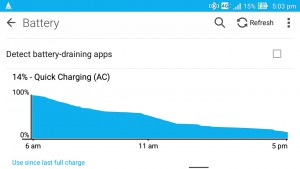
Some Ausdroid staff will disagree with me but I feel that in 2015 and beyond every single phone should include some form of turbo or quick charging. It is incredibly handy, even more so than Qi charging. I feel this feature is becoming a standard, especially with the Qualcomm-toting devices. For Asus to enable it on the Intel chip in the ZenFone 2 increases the attractiveness of the device, although the inclusion of a charger capable of charging at this rate may have been a decent idea.
Camera
The Asus camera app is not ground breaking but it is definitely not offensive in anyway. Most things you may need are within a single tap of self explanatory buttons. There are also popup hints to help you take decent photos depending on how Asus perceives the environment. A reminder to use HDR or low-light mode pops up when required.
The camera itself is 13MP rear facing and 5MP front facing. While the pictures the Asus ZenFone 2 took were acceptable for a phone camera, there weren’t up to the standard currently being set by Samsung with the S6 and LG the G4. It performed well in good light but like many it did struggle when the light got to low levels. Turning on low light setting dropped the MP to 3MP and using HTC’s theory,allowed more light per pixel resulting in a brighter image.
The 5MP front facing camera had the beautification applied to it by default, which I hated as it made the image look fake. This can be turned off by choosing a different setting but I personally think it should be the other way around, applied afterwards if required.

For a relatively cheap phone the camera on the ZenFone 2 was excellent. I certainly didn’t avoid using it as I would for one of poor quality.
Connectivity
As with most phones these days the Asus ZenFone 2 supports many 3G and LTE bands. It supports HSDPA 850/900/1900/2100 and LTE bands 1,2,3,4,5,7,8,20. The signal is acceptable but not brilliant like I found it to be on my Nexus 6. I work in a department filled with lead-lined walls and Faraday cages so reception is a challenge at the best of times but most of the time I was able to get some reception on the ZenFone 2.
It supports Wifi 802.11 a/b/g/n/ac and bluetooth v4.0. It has all the usual GPS bells and whistles (A-GPS and GLONASS) and supports usb 2.0 only (no type C connector here of course). A good inclusion that Google will never do is the FM radio. Not everything is streamed these days Google. The manufacturers have it correct. Sometimes we want to listen to the radio (eg. AFL) without using our data plans. Not many of us have unlimited data plans.
Sound
The sound out of it was better than many other devices I have tried and Asus have included a decent equaliser into their ROM which did help with the sound quite a bit. As someone who listens to a lot of music via bluetooth I can say that I found the sound from the ZenFone 2 to be above average (not perfect and not brilliant but certainly not the worst I have used). If you are an audiophile this is not the phone for you but if you just like good music then there is nothing wrong with the output from this device.
Performance
I touched on performance in the hardware section. The lag was normally when switching apps but when already in an app the performance was quite good. Using the usual test app of Riptide GP2 there was no noticeable stuttering at all. with the graphics being rendered as expected.
Software
I am the first to admit that I am a Nexus fanboy. I love the clean Android experience that the Nexus and it’s custom ROMs provides. In saying that I am often jealous about the features that some manufacturers include into their phones to distinguish themselves from others. Many times I have wished that Google would do more with the camera UI, would do more with the customisation of the Android experience (ie. things that can often only be found in custom ROMs) because, let’s face it, custom ROMs are rarely as stable as the ROMs manufacturers install on their phones.
After using this cheap, low end Asus phone I am convinced that maybe Nexus is not the best experience I can have on an Android device. This low end Asus device was able to deliver a user software experience that was surprisingly similar in features to a custom ROM but without the instability often associate with custom ROMs. Asus have done a great job in picking and choosing what they include into their factory ROM that I think all the other manufacturers should sit up and take a close look at. Their apps are all updated via the Play Store meaning more frequent updates to apps to fix bugs etc. Their own apps cannot be uninstalled but they can be disabled as required.
The custom ROM-type features Asus have included are DT2W, customisable themes and icon packs (the standard icon packs from the Play Store usually associated with custom launchers work perfectly), off screen gestures (ZenMotion), double tap the status bar to turn off the display, customisable quick settings, custom display colour settings and showing the battery percentage. All of these worked perfectly every single time. Being able to launch the torch from the display while the phone is off is extremely useful, as was the quick launch gesture for the camera. The gestures are set in stone by Asus but what each gesture launches isn’t. They can be customised to whatever app you choose.
Even though the display is only 5.5in Asus have included the ability to shrink the screen down for single handed use, just by double tapping the home button. While I didn’t use this I can see where it would be handy.
The Asus launcher is good but not great. It is possibly the best manufacturer launcher I have used but it is still not a pinch on Nova or Apex etc. It still bewilders me why Asus, and all other manufacturers, cannot do a deal with one of these custom launcher developers to include them in their ROMs. They often include keyboards (Swype), or other apps that are far less useful (task managers, anti-virus apps) so why not include something like this.
With Asus decoupling so many, possibly all, of their included apps from their framework it seems that they are quick with updates. In the 16 days I’ve had the device there has been three system updates- none of them major but all with small bug fixes. Whether this translates into Android version updates in the future remains to be seen but we can only hope that they continue to support this device in the coming months and years.
Asus have included a plethora of apps in with the ZenFone 2, many of them useful, well thought out apps. The general design of the apps is consistent through-out all of them making the theme seamless and well thought out. Their theme, while not entirely Material Design, it is not entirely hideous. Interestingly they have included their own version of Google now that tells you your calendar for the next day as well as the weather for the next day. Handy once again to have that pop up as a notification the night before showing your agenda for the following day.
Asus ought to be commended for including so many useful apps that are lightweight and not gimmicky but unfortunately they have lost some of that goodwill gained by including some third party bloatware, including an anti-virus app, a task manager, a shopping app, a travel app and a chat app (among others). None are required for an Android device to work at it’s best. Luckily, they can all be uninstalled through the device settings
Android OS
The Asus ZenFone 2 comes with 5.0 out of the box and there appears to be no idea of when it will receive 5.1. I suspect that many of the updates I have been seeing while having the device for such a small time are them fixing the many small bugs associated with 5.0 as many of the known 5.0 issues are non-existent or unnoticeable.
The Asus skin is minimal but at the same time consistent. They may have themed the entire system to their ZenUI but the changes they have made are minor. Rather than change things around they have seemingly changed colours and icons. This made the user experience an enjoyable one (although I still prefer Material Design.
Asus have done a decent job with their version of Lollipop and I know our esteemed editor here at Ausdroid will fall off his chair that my next phone will not be a Nexus. I think I could handle putting up with a bit of ugly manufacturer skin (within reason of course, I did say only a bit) for the extra goodies that they include with their devices.
Asus ZenFone 2 ZE550ML Specifications
- 5.5in, 720 x 1280 display(~267 ppi pixel density)
- Intel Atom Z3560, Quad-core 1.8GHz
- PowerVR G6430 GPU
- 16GB onboard storage, 2GB RAM
- MicroSD slot
- Dual sim
- Wi-Fi 802.11 a/b/g/n/ac,Bluetooth v4.0
- 13MP rear-facing camera with dual LED flash and f/2.0 aperture
- 5MP front-facing camera
- 3000mAh battery with fast charging
- Android 5.0
- 152.5 x 77.2 x 10.9mm, 170gm
- LTE bands 1,2,3,4,5,7,8,20
We hear a lot in the tech media regarding flagships. We hear about all the high end releases about all the features they have, all the fastest processors but we hear very little about the mid to lower range phones. There is certainly a market for the mid to lower range phone. Not everyone needs the features and power of a flagships and not everyone can afford a flagship. For those people there is the Asus ZenFone 2 (among others).
The ZenFone 2 ZE550ML may not have the greatest specs but it is not meant to. It is priced at under $300 and for that price you really shouldn’t expect much. The Asus ZenFone 2 delivers far and above what it’s price suggests. The 5.5in display is only 720p but it wasn’t long ago that this was high end. It is certainly not a bad display. The Intel processor inside handles all the high powered games I threw at it and my Riptide GP 2 score is now at an all time high. Add in a microSD slot as well as a second sim card slot and the hardware is certainly good bang for your buck.
Asus have also added a lot of useful features to their ROM normally associated only with custom ROMs and as such found using it extremely user friendly with the experience being a pleasant one. They have included all their apps as per normal but they are all installed and updated through the Play Store resulting in fast updates and bug fixes to all of them. Most of the apps were very useful and all were themed nicely. The UI was certainly not ugly like some other manufacturers (although this number is getting shorter by the day).
There was some slowing down and lag of the device after constant usage over a short amount of time but this I attributed to mostly the memory bugs hidden within Lollipop. The higher end ZenFone 2 (ZE551ML) may hide these somewhat, having 4GB of RAM as well as a faster processor.
For those looking for an affordable phone I can certainly recommend the Asus ZenFone 2 ZE550ML. It is a striking phone that delivers more than it promises. Our review unit was provided by Expansys Australia where you can purchase it for $265 plus shipping. It can be found at other online retailers including Kogan for $279 plus shipping. It is available in red, black and white varieties.

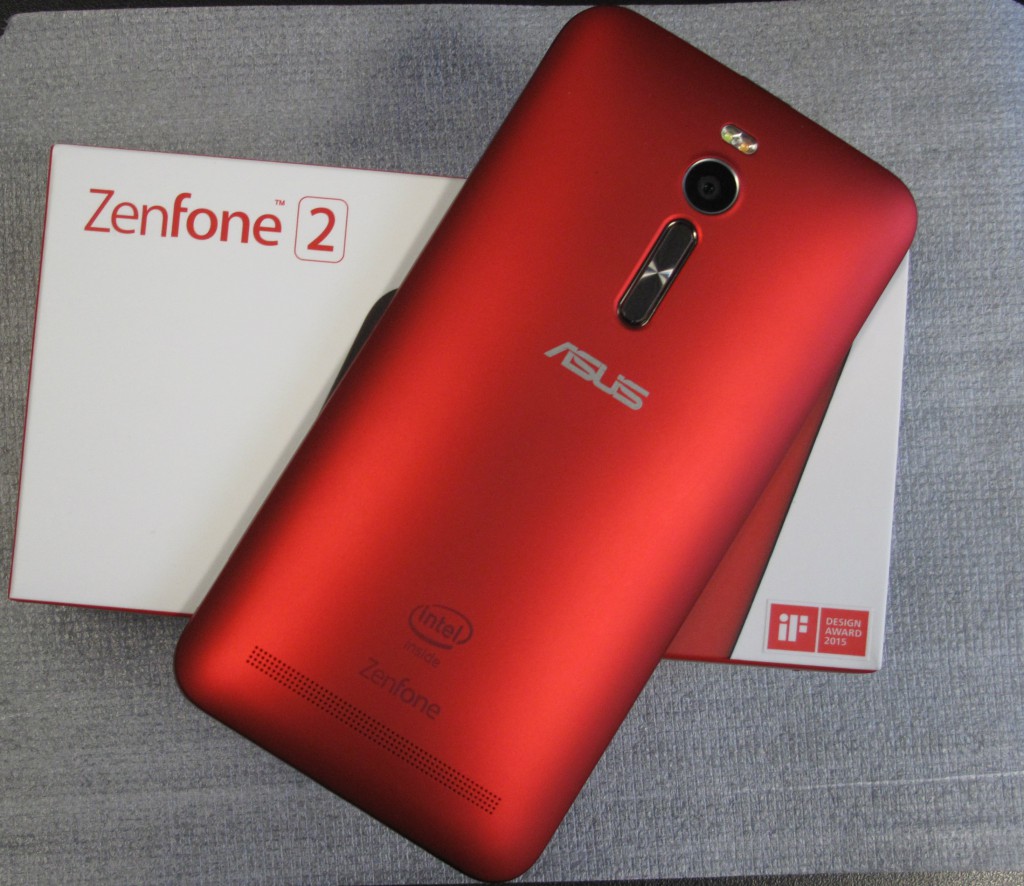


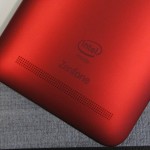

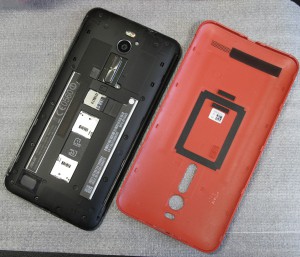
















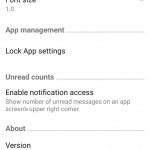
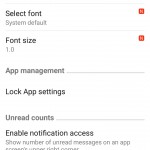
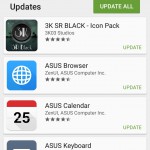


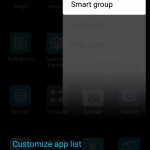

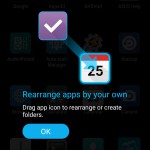
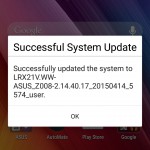



Thanks for the great write-up! I see that this phone is not perfect (d’oh, what phone is? silly me :D) but you listed all the warts objectively, and I can live with them all 🙂
I’ve been hunting for a phone to ‘assist’ my currently creaking-on-the-joints Sony Xperia SP, and this phone seemed to fit my needs *and* budget, and your review cinches the deal.
Again, thanks!
As at 22 June 2015 the Zenfone 2 is NOT released in Australia by ASUS so their service centres do not support it or repair it as they do not stock any parts – e.g a screen replacement!! I found out the hard way!!
Good to see a comprehensive review of a non-flagship phone! Those seem too few and far between; not everyone needs the latest and greatest.
P.S. Scott…Please, if the phone isn’t contributing to your workout, it’s detracting! Resting inter-set is such a great time to get in touch with your body’s sensations and improve your physical intuition; treat your whole workout block like you’d treat a yoga session and you might find that a positive change.
P.P.S. Sorry for the unsolicited exercise advice! If it helps, I’m certified? 😉
Another tip for Scot Plowman: Double-tap the top notifications bar to put the screen to sleep. As you said, double-tap the screen to wake it up.
Did I forget to mention that?had it in my notes regarding it being a custom rom.
Also must add that if you follow the Whirlpool Forums (Android phones section) the device you should get is the Taiwan version, which supports Band 28 700Mhz 4G LTE, which Optus and Telstra are rolling out nationally. You don’t get 2600Mhz (as in the Hong Kong version), but at the moment, that is only used in Canberra. I obtained the Taiwan version through an ebay seller, got it inside four days.
Great review, fellow user in full agreement. I have the same model with black rear cover, which doesn’t look as premium (or as attractive to steal ;). I’ve had trouble with a yellow cast on photos using the flash – not sure why the dual flash seems to have a yellow and orange filter over each of them. The ASUS camera app has a well featured manual mode which can adjust the colour temperature, though. Any ideas for fixing this? Extremely capable as a cheap do-anything 4G 5.5inch phone. I also have one software issue: Google Music notification control doesn’t… Read more »
Looking forward to your review of the ZTE blade s6 (exactly the same price point) as a comparison to this phone
For a $300 phone, that’s a pretty damn compelling device.
Great review Scott. Does this version have an FM Radio built in and did you use it? Would this be your No.1 recommendation for a sub $300 phone right at the moment?
One last question, would you buy one with your own money?
Forgot to say in the review that yes it does have an fm radio. Definitely recommend for sub $300
Thanks very much for this review Scott.
One thing in the pics which ASUS did correctly is that they NAMED their replacement apps for stock AOSP/Google apps, as clearly being theirs.
Question: Why are there no photos of the front of this device showing the capacitive buttons?
Very good question Jeni. There are no pictures because I took it out to edit it and forgot to put it back in. Will fix now. Sorry.
Thanks Scott
🙂
What do you think of the capacitive buttons? I would not normally even consider them.
I think I still prefer not to have them but I got used to having them. My issue with them (and Google’s stock android implementation) is the inability to customise what each does. Asus do have this in very minor detail but they, and other companies need to do more imo.
I will now, not automatically dismiss a phone with them though.